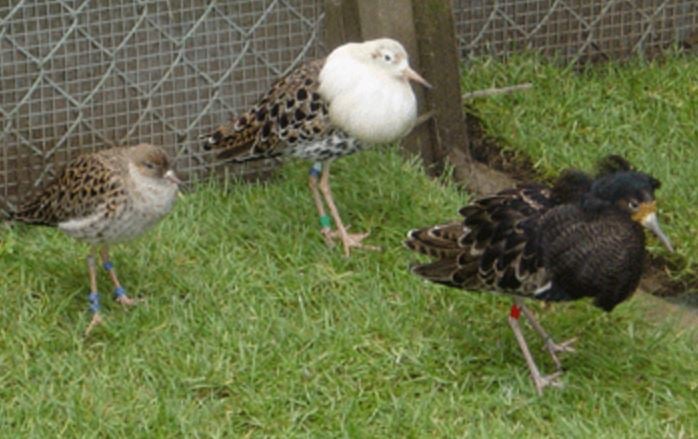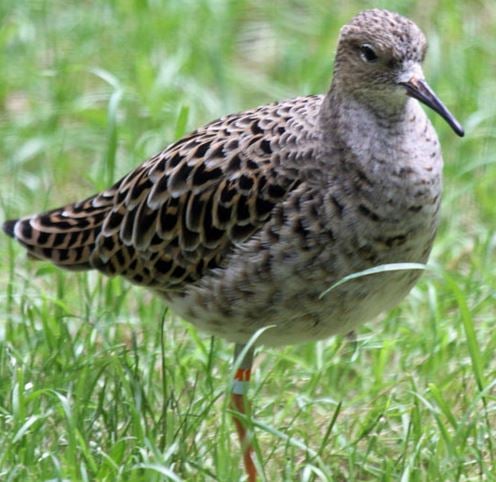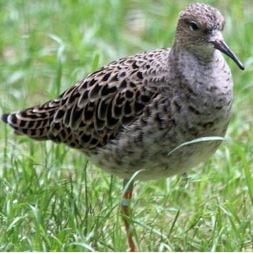Whether you are into cross dressing, girlfriend snatching, or have a strong territorial instinct, is all down to your genes, that is, if you are ruff – a medium-sized wading bird that has a long neck, small head, a rather short and slightly droopy bill, and orange-reddish legs.
Researchers from the University of Sheffield in England, the University of Edinburgh in Scotland, and Simon Fraser University in Canada, explain that individual animals generally exhibit flexibility in their behaviour, but some of the ways they behave is determined by their genes.
The ruff has a ‘lek’ mating system, i.e. the males gather together and use up all their energy trying to attract females to mate with them. No energy at all, however, goes into caring for and rearing their young.
 Three morphs of ruff: 1. The cross dresser (left). 2. Satellite (middle). 3. Territorial (right). (Image: sheffield.ac.uk)
Three morphs of ruff: 1. The cross dresser (left). 2. Satellite (middle). 3. Territorial (right). (Image: sheffield.ac.uk)
Ruff has three distinct breeding behaviors
Within the ruff’s mating system, three distinct breeding behavior types are clearly observed.
Territorial breeding males have a spectacular plumage around their neck and head, hence their name. Each male has a unique colouration, making it quite easy to tell them apart.
So-called ‘satellite’ males, the non-territorial ones, which have a white plumage, spend all their time trying to steal females from the territorial displaying males.
There is also another type of male – a cross-dresser that tries to look like a female, and succeeds. They are able to hide in plain sight from the other males in the lek, and avoid being attacked. They are also extremely effective at stealing mates from the resident males.
Imagine a human male who enters a harem of females disguised as a woman, and has sex with them when the husband is not looking. That is what the cross-dressing ruff does. In the ruff’s case it does not choose to mimic a female, its genes do that.
All down to encoding by a ‘supergene’
The researchers, who published their findings in the academic journal Nature Genetics, say their study shows that three distinct breeding behaviour types are encoded by a ‘supergene’ – a small section of a chromosome that contains a at least one hundred genes.
 The territorial male ruff cannot tell the cross dresser from the females. (Image: Wikipedia)
The territorial male ruff cannot tell the cross dresser from the females. (Image: Wikipedia)
A chromosomal rearrangement created this supergene many millions of years ago, which originally allowed the cross dresser to evolve and coexist with the territorial males.
Lead author, Professor Terry Burke, who works at Sheffield University’s Department of Animal and Plant Sciences, said:
“The special feature of the supergene is that it allows lots of genes that are next to each other on a chromosome – which in this case determine multiple traits including hormones, feathering, colour and size – to evolve together and create two distinct behavioural traits.”
“This process is similar to the one that led to the evolution of separate sex chromosomes, and indeed the alternative forms of the supergene combined together to create the third type of bird personality – the girlfriend stealer.”
The authors say the ruff provides a neat example of how tiny genetic changes can lead to significant differences in behaviour and attractiveness, a process that is fundamental to the formation of separate species and separate sexes.
Prof. Burke added:
“Unlike young men at a social occasion who have each chosen a different approach to courtship, whether that’s showing off or paying a compliment, for these birds there is no choice in the matter. It’s their DNA that dictates how they win a partner.”
Citation: “A supergene determines highly divergent male reproductive morphs in the ruff,” Clemens Küpper, Michael Stocks, Mark Blaxter, Judith E Risse, Natalie dos Remedios, Theunis Piersma, Lindsay L Farrell, Susan B McRae, Yvonne I Verkuil, Tawna C Morgan, Natalia Karlionova, Pavel Pinchuk, Alexander S Kitaysky, John C Wingfield, Kai Zeng, Jon Slate, David B Lank & Terry Burke. Nature Genetics. 16 November, 2015. DOI: 10.1038/ng.3443.

